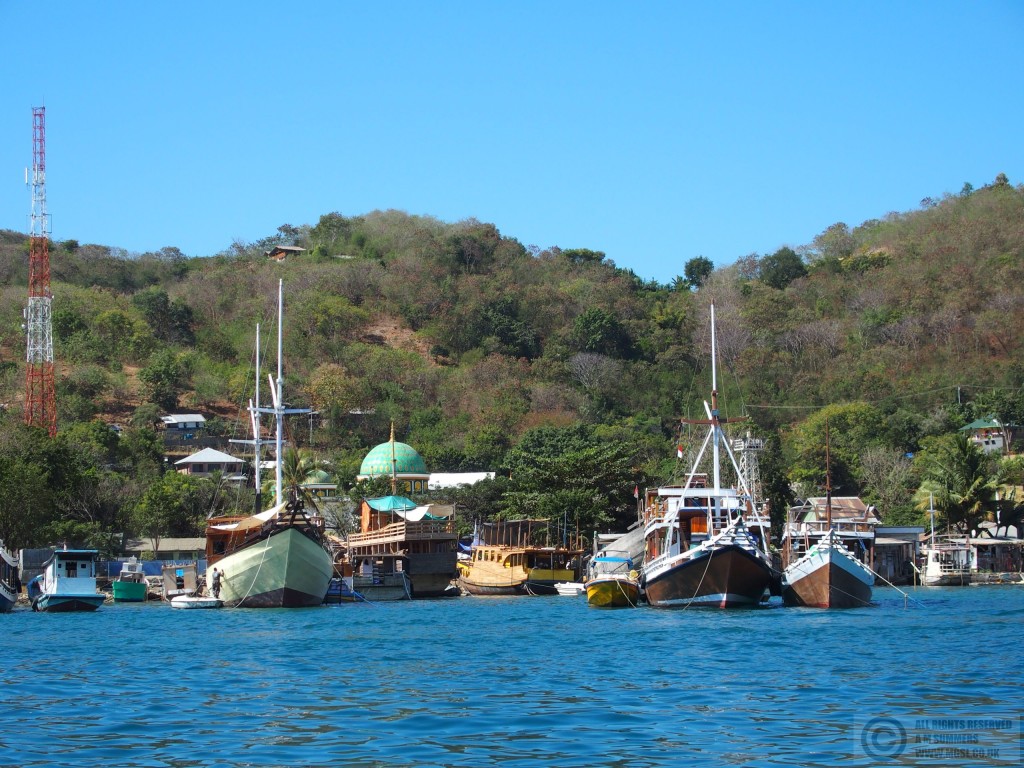A trip to see Komodo dragons on Rinca
Unless you shell out an enormous sum for a speedboat, it’s really not feasible to visit Komodo as a day trip from Labuan Bajo – it’s a 4-hour journey each way. There are overnight trips where you sleep on the boat, but stories of rat-infested, leaky sweatboxes seemed all too common, so we opted for a day trip to Rinca. There are fewer dragons there than on Komodo, but they are easier to find.
The price you pay depends largely on how many people are on the boat – it would have been cheaper to join a boat where others had already booked, but we were really hoping to be on our own so that we could dictate the timetable. We didn’t want our time on Rinca to be rushed in order to fit in 2 separate snorkelling stops, which seemed to be the standard itinerary. Seeing Komodo dragons was the priority: snorkelling could wait for another day if necessary. So we booked late in the afternoon and crossed our fingers.
The strategy worked and at 07:30 we set off for the harbour with Arish, a 17 year old tourism student from Ruteng who was getting some work experience during his holidays. The wooden boat to which we were led didn’t have the toilet that we’d been assured it would have, so we insisted on a change of vessel. Unfortunately in the kerfuffle Arish left our lunches on the first boat, so we had to turn back before we even got out of the harbour.
The 2 hour journey to Rinca took us across millpond water, our route hugging the west coast of Flores. I was glad it was calm – the toilet was an arrangement of planks suspended over the back of the boat, so in a rough sea there would be a pretty good chance of tumbling in. There were a few settlements on small offshore islands and on the mainland coast, but even the latter were only accessible by sea – steep hills rise immediately inland (dry and brown at this time of year) and there are no roads. Arish claimed that the inhabitants were all fishermen and consequently rich. The villages didn’t exactly look rich, but perhaps compared with the rice farmers of Flores’s rural interior they are.
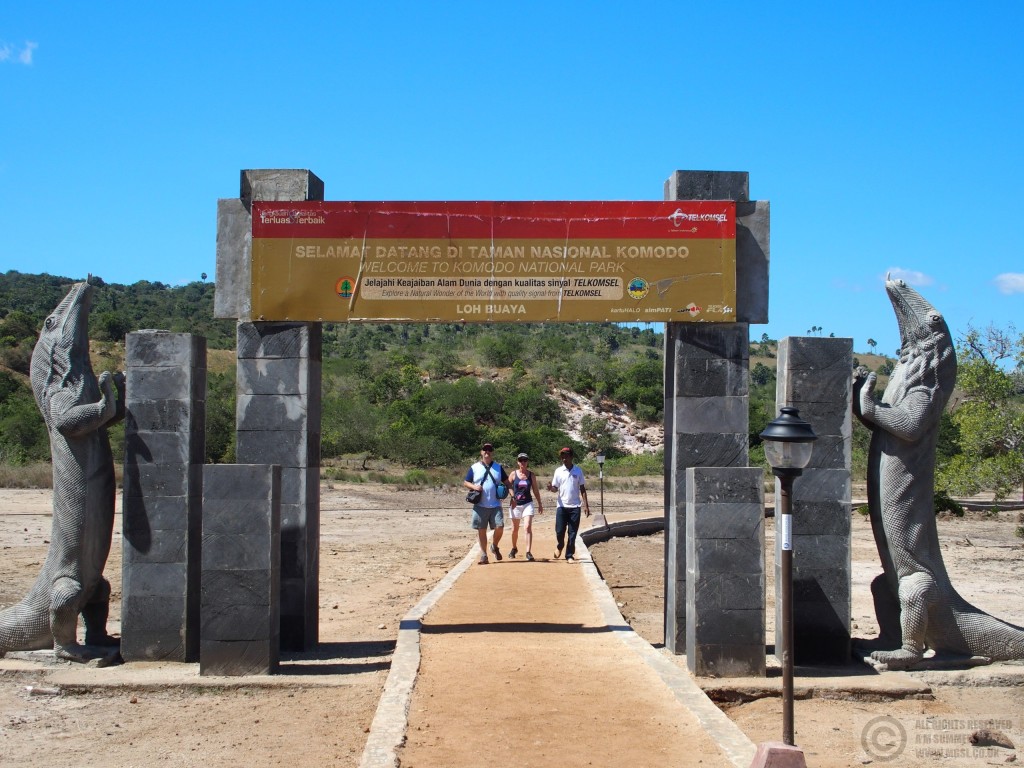
Arriving at Komodo National Park
The jetty at Loh Buaya was already crowded with tourist boats like ours but our driver manged to find a gap and nose in, and Arish went off to get our guide – you’re not allowed to wander around unaccompanied. All the rangers carry long, stout forked sticks with which to fend off any Komodo dragons that get too close. I’m not aware of any tourists being bitten in recent years, but a ranger was bitten while in his office a few years ago. Fortunately he survived. The idea that Komodo dragons kill by delivering a dose of bacteria has now been discounted – it’s the haemorrhagic toxin that does the trick for small animals, while the wounds on the larger water buffalo get infected from the dirty water in which they wallow.
But before dragons, money. A Rp150,000 park entrance fee, Rp50,000 tourist tax, Rp80,000 ranger fee (per group) – it all added up to about £25 for the two of us. The uniformed official taking the money was quite sweet though, standing to shake our hands and deliver a little formal speech of thanks for visiting.
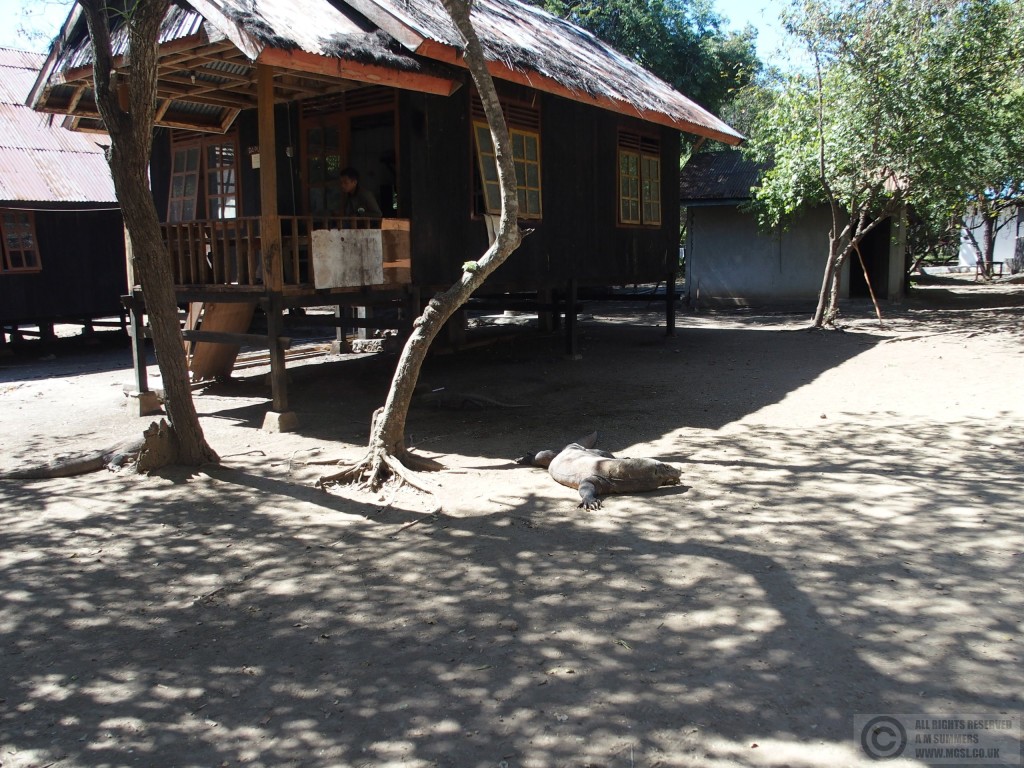
Adult dragon in the ranger camp
The deal at Rinca is that you can follow a half hour, one hour or two hour route. We’d told Arish that we wanted the two hour route as we thought this would maximise our chances of seeing dragons, but our guide Konstantin firmly told us that we’d be following the one hour route but would take two hours over it. Perhaps he didn’t think we looked very fit, but mainly I think the two hour route goes up onto a ridge and into more open country, and at this time of year the dragons are lurking in the shadier valley bottom.
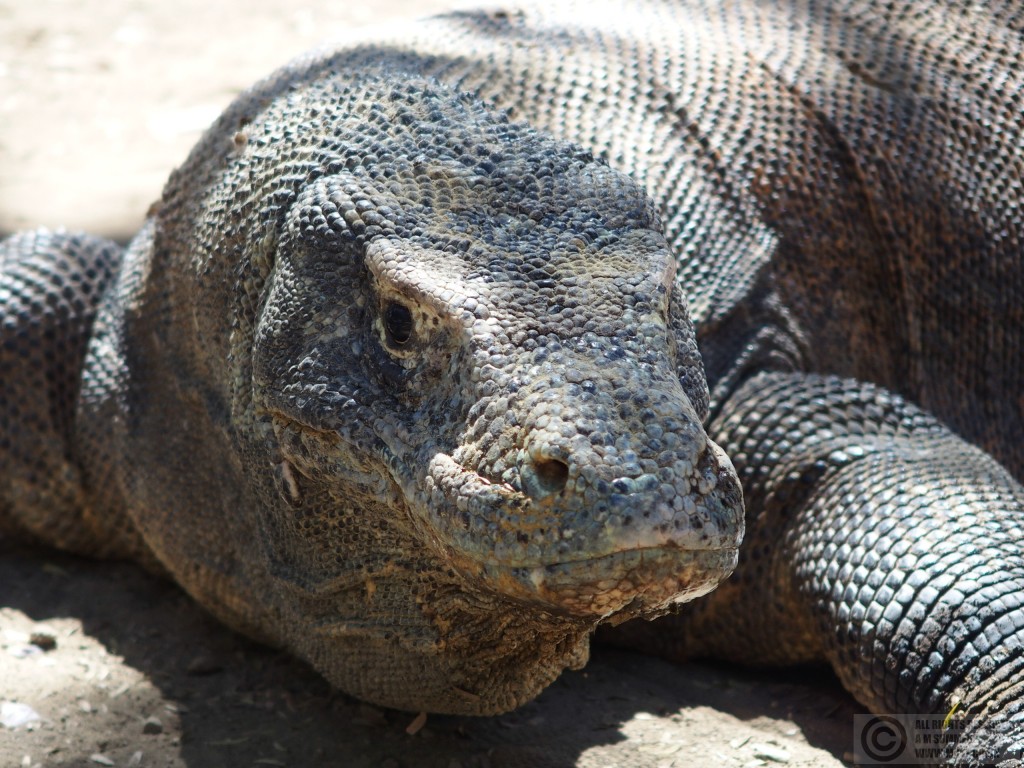
Not friendly!
We saw a small dragon, perhaps 4ft long, almost immediately, then several others around the camp. This was apparently unusual, as juveniles normally stay in the trees to avoid becoming a snack for one of their larger cousins. Then a full size dragon, slumbering by one of the huts. It was about 8ft long, not quite as large as I’d imagined (the ones on Komodo grow larger, we later learned), but even half asleep it did not look friendly, sweeping its gaze slowly around the half circle of camera-snapping tourists and no doubt wondering if it could cover the 20ft gap fast enough.
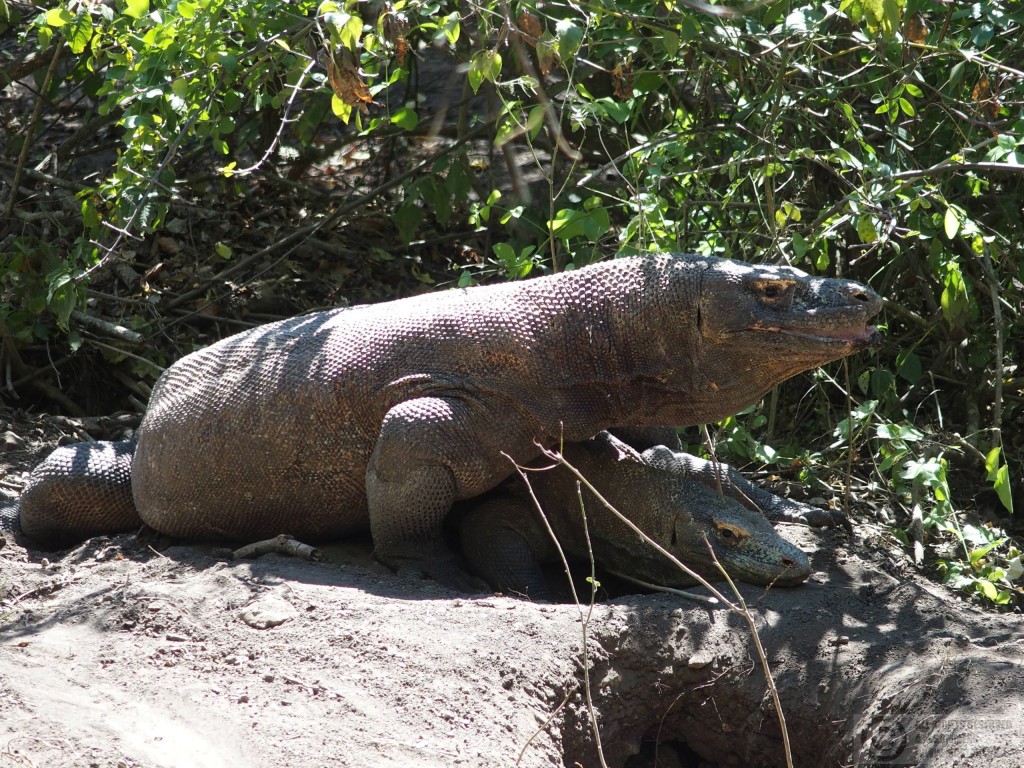
Even Komodo dragons need love
Moving away from the camp it wasn’t long before the next sighting – this time a mating couple. They lay next to a couple of scraped hollows into which eggs would later be laid (they dig extra holes as decoys for egg-hunting scavengers). Komodo copulation is evidently a fairly relaxed process – they simply lay immobile for the 15 minutes or so that we watched them.
5 minutes further along another solitary dragon lay right beside the footpath – Konstantin had to hold out his stick protectively so that we could edge past him. And that was it for dragons on the walk – the remaining hour was a pleasant stroll through the forested valley floor, alongside a dry stream bed, then up a low ridge through grassland and shrubs back to camp, with some views of Rinca along the way. Rinca is quite a large island, and there is a village a few kilometres from the camp. Konstantin lived there, travelling to work by boat – safer than going by land.
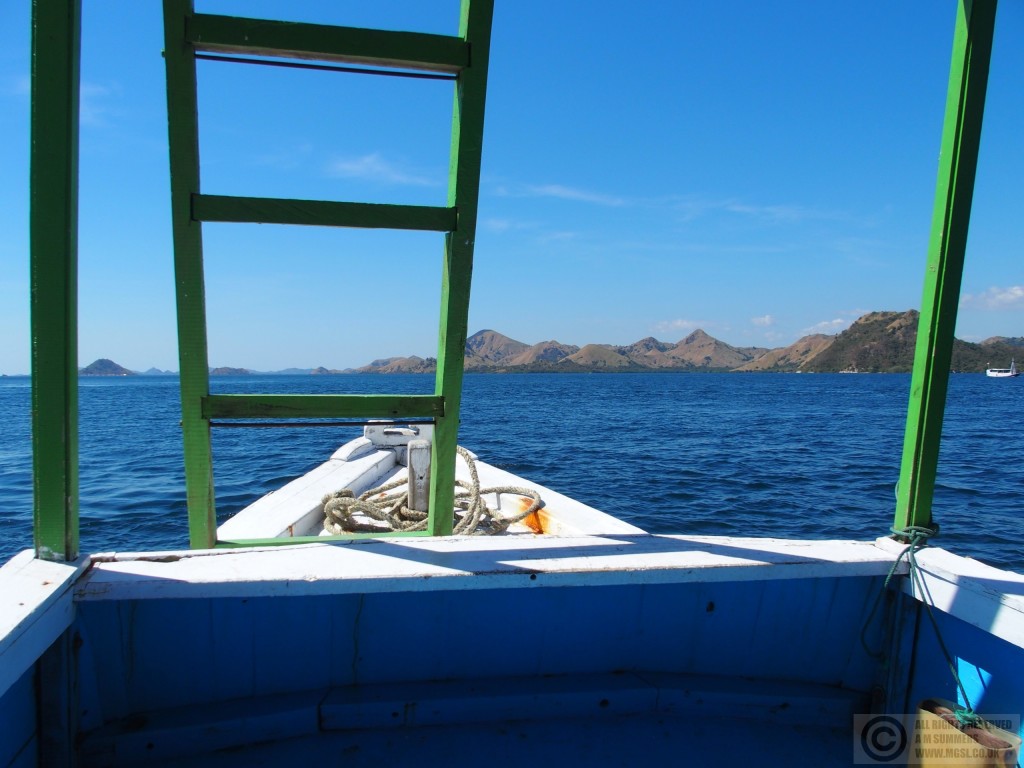
En route to Bidadari
Back at the camp we tipped Konstantin generously and boarded our boat. We ate our lunch on the way to our first snorkelling stop at Kalong, a very bony fried fish with rice and a few vegetables, washing our greasy fingers in seawater. The white sand beach at Kalong was already quite busy when we pulled up. As there was no ladder on board Arish placed one of the plastic chairs in the shallow water and we clambered down via that. Kalong has a narrow reef with schools of small fish and a bit of coral, but the water was cloudy from stirred sediment and something kept stinging us, so we didn’t stay too long.

Swimming at Bidadari
The second snorkelling stop was at Bidadari, “Angel Island”. Here there was just one other boat and a French family in the water. The snorkelling was clearer here, fewer fish but larger ones, especially parrot fish, and purple coral, and an electric blue soft coral. And no stingers. It was probably the wrong environment for rays, but we had seen one briefly at the surface on the way from Kalong.
I could have stayed longer but it was time to head for harbour and home. Smiles all round at the probably over-generous tips for Arish and the two boat guys, but we’d had a fantastic day, and for Mr Vagabond it was the realisation of his childhood dream of seeing Komodo dragons. It took a long time, but it was worth the wait.



